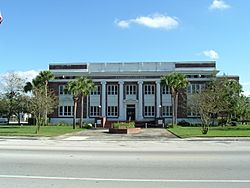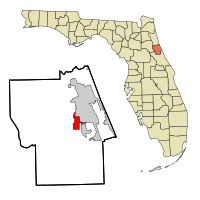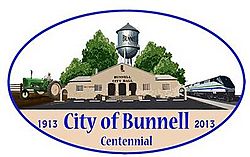Bunnell, Florida facts for kids
Quick facts for kids
Bunnell, Florida
|
||
|---|---|---|
| City of Bunnell | ||

Old Flagler County Courthouse
|
||
|
||

Location in Flagler County and the state of Florida
|
||
| Country | ||
| State | ||
| County | Flagler | |
| Settled | 1880s | |
| Incorporated (town) | 1913 | |
| Incorporated (city) | 1924 | |
| Government | ||
| • Type | Commission–Manager | |
| Area | ||
| • Total | 139.86 sq mi (362.24 km2) | |
| • Land | 139.80 sq mi (362.07 km2) | |
| • Water | 0.06 sq mi (0.16 km2) | |
| Elevation | 20 ft (6 m) | |
| Population
(2020)
|
||
| • Total | 3,276 | |
| • Density | 23.43/sq mi (9.05/km2) | |
| Time zone | UTC-5 (Eastern (EST)) | |
| • Summer (DST) | UTC-4 (EDT) | |
| ZIP code |
32110
|
|
| Area code(s) | 386 | |
| FIPS code | 12-09550 | |
| GNIS feature ID | 0279682 | |
Bunnell is a city in Florida, United States. It's the main town, or county seat, of Flagler County. In 2020, about 3,276 people lived there. Bunnell is part of a larger area that includes cities like Deltona and Daytona Beach. The city got its name from Alvah A. Bunnell, who was one of the first people to live there. He made shingles (roof tiles) and supplied wood for the early train industry.
Contents
Exploring Bunnell's Location and Size
Bunnell is located in the middle of Flagler County. Its city limits now reach south and northwest to the county line. The cities of Palm Coast are to Bunnell's north and east.
How to Get Around Bunnell
U.S. Route 1 goes through the center of Bunnell. It's known as State Street in the city. This road leads about 31 miles north to St. Augustine. It also goes about 18 miles southeast to Ormond Beach.
Florida State Road 100 takes you about 8 miles east to Flagler Beach. It also goes about 30 miles northwest to Palatka. If you're looking for Interstate 95, it's about 4 miles east of downtown Bunnell. You can reach it using State Road 100.
Bunnell's Land and Water Area
The city of Bunnell covers a total area of about 138.5 square miles (358.9 square kilometers). Most of this area, about 137.5 square miles (356.0 square kilometers), is land. Only a small part, about 1.1 square miles (2.9 square kilometers), is water. This means about 0.81% of the city's area is water.
Since the year 2000, Bunnell has become the second-largest city in Florida by land area. This happened because it added over 87,000 acres, which is about 136 square miles (352.238 square kilometers), to its size.
Bunnell's Climate: Warm and Humid
Bunnell is located in a humid subtropical climate zone. This means it has mild winters and hot, humid summers. The climate is often described as "Cfa" according to the Köppen Climate Classification system. The "C" stands for mild temperate, "f" means it's fully humid (it rains all year), and "a" means it has hot summers.
How Many People Live in Bunnell?
| Historical population | |||
|---|---|---|---|
| Census | Pop. | %± | |
| 1920 | 682 | — | |
| 1930 | 671 | −1.6% | |
| 1940 | 1,030 | 53.5% | |
| 1950 | 1,341 | 30.2% | |
| 1960 | 1,860 | 38.7% | |
| 1970 | 1,687 | −9.3% | |
| 1980 | 1,816 | 7.6% | |
| 1990 | 1,873 | 3.1% | |
| 2000 | 2,122 | 13.3% | |
| 2010 | 2,676 | 26.1% | |
| 2020 | 3,276 | 22.4% | |
| U.S. Decennial Census | |||
Bunnell's Population Over Time
The number of people living in Bunnell has changed quite a bit over the years. In 1920, there were 682 residents. By 2020, the population had grown to 3,276 people. This shows how the city has grown and developed over many decades.
Who Lives in Bunnell? A Look at the 2020 Census
The 2020 United States census counted 3,276 people living in Bunnell. There were 1,072 households, which are groups of people living together in one home. Out of these, 592 were families.
The census also looks at the different backgrounds of people living in the city. Here's a quick look at the main groups in 2020:
- Most residents, about 64.13%, were White (not Hispanic).
- About 23.60% were Black or African American (not Hispanic).
- About 7.23% of the population was Hispanic or Latino (this group can be of any race).
- Smaller groups included Asian (0.73%), Native American (0.37%), and people of two or more races (3.66%).
Historic Buildings and Landmarks in Bunnell
Bunnell has several interesting old buildings that tell stories about its past. These buildings are important parts of the city's history.
- Bunnell Water Tower: A tall structure that holds water for the city.
- Lambert House: This is the oldest building still standing in Bunnell. It was built in 1909 by James Frank “Major” Lambert.
- Old Bunnell State Bank Building: This building was made of masonry in 1910. It was added to the U.S. National Register of Historic Places in 1992.
- George Moody House: Built in 1917, this house is in the Craftsman style, known for its handmade look.
- William Henry “Doc” Deen House: A frame house built in 1918.
- Holden House Museum: This Craftsman bungalow from 1918 is now owned by the Flagler County Historical Society. It's a museum where you can learn about local history.
- Old Flagler County Courthouse: This grand building was designed in the Neoclassical style by Wilbur Talley in 1926. It was officially opened on July 28, 1927.
- Little Red School House Museum: Students from Bunnell High School's Future Farmers of America program built this schoolhouse in 1938. It's now a museum.
Famous People from Bunnell
Many talented people have come from Bunnell, Florida. Here are a few:
- W. H. Atkinson: A racing driver who competed in NASCAR.
- Mardy Gilyard: A professional NFL football player.
- Eddie Johnson: A player for the United States men's national soccer team.
- Bill T. Jones: A famous choreographer who won a Tony Award for his dance work.
- Terence Steward: A former NFL football player.
- Charlie Turner: A musician.
- Alvah Alonzo Bunnell: The person the city is named after, considered its founder.
See also
 In Spanish: Bunnell para niños
In Spanish: Bunnell para niños


